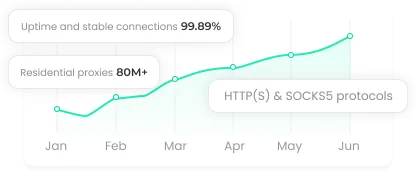How to Choose Between HTTP and WebSocket for Web Scraping
Web communication isn’t one-size-fits-all. Some tasks thrive on simplicity, others demand real-time responsiveness. When it comes to proxies and web scraping, picking the wrong protocol can slow you down—or worse, break your workflow. HTTP and WebSocket may both move data across the internet, but they do it in very different ways. Understanding these differences is key to building efficient, reliable scraping setups and real-time applications.

HTTP: The Classic Workhorse
HTTP (Hypertext Transfer Protocol) is the backbone of the web. Every time you load a website or fetch data from an API, HTTP is working behind the scenes. Its request-response model is straightforward: the client asks, the server replies.
How HTTP Operates
Client request: You send a GET, POST, or other request specifying the resource you need. Headers and sometimes a body carry additional information.
Server response: The server processes the request and returns a status code, headers, and the content you asked for—HTML, JSON, images, anything.
Connection closure: HTTP/1.1 and earlier versions close the connection after each response. HTTP/2 and HTTP/3 improve efficiency by keeping connections open longer and supporting multiple streams at once.
Key Traits of HTTP
Stateless: Each request stands alone. Session info requires cookies, tokens, or similar mechanisms.
Synchronous model: Requests wait for responses—no shortcuts.
Text-based: Easy to debug using tools like cURL or browser developer tools.
Caching support: Reduces redundant server requests through headers like Cache-Control.
Secure: HTTPS encrypts communication to protect sensitive data.
WebSocket: Real-Time Communication
WebSocket flips the script. Instead of request and response, it allows constant, bidirectional communication. Once connected, the client and server can exchange messages instantly—no repeated handshakes, no waiting.
How WebSocket Operates
Handshake: A client requests a protocol upgrade via HTTP. The server replies, and boom—the persistent connection begins.
Persistent connection: Messages flow freely in both directions without opening new connections.
Message exchange: Supports text (UTF-8) or binary data. Flexible and fast.
Key Traits of WebSocket
Bidirectional communication: No waiting for requests. Data moves as soon as it's available.
Low latency: Eliminates repeated connection overhead.
Efficient bandwidth usage: One handshake, minimal headers.
Versatile data support: Works with text and binary, ideal for complex applications.
Choosing Between HTTP and WebSocket for Proxies
For most web scraping tasks, HTTP remains the standard. Proxies handle HTTP effortlessly, masking your IP and helping distribute requests to avoid bans.
WebSocket, however, adds complexity. Proxies must support persistent connections and handle binary data efficiently. Firewalls, corporate networks, or some VPNs can block WebSocket traffic, making configuration trickier—but it's important for live applications like trading platforms, messaging apps, and live social feeds.
Practical Web Scraping Scenarios
When to Stick with HTTP
Static sites and fixed HTML content
REST APIs with structured JSON or XML
Multi-page content or paginated listings
Forms, logins, and standard authentication flows
When WebSocket Is Necessary
Live stock prices, crypto values, or sports scores
Chat applications and instant messaging data
Live social feeds or interactive dashboards
Online auctions or gaming platforms
Conclusion
With HTTP, you get simplicity and wide support. With WebSocket, you gain real-time responsiveness. Knowing when and how to use each—especially behind proxies—can make all the difference between a scraping workflow that runs smoothly and one that constantly fails.


















































